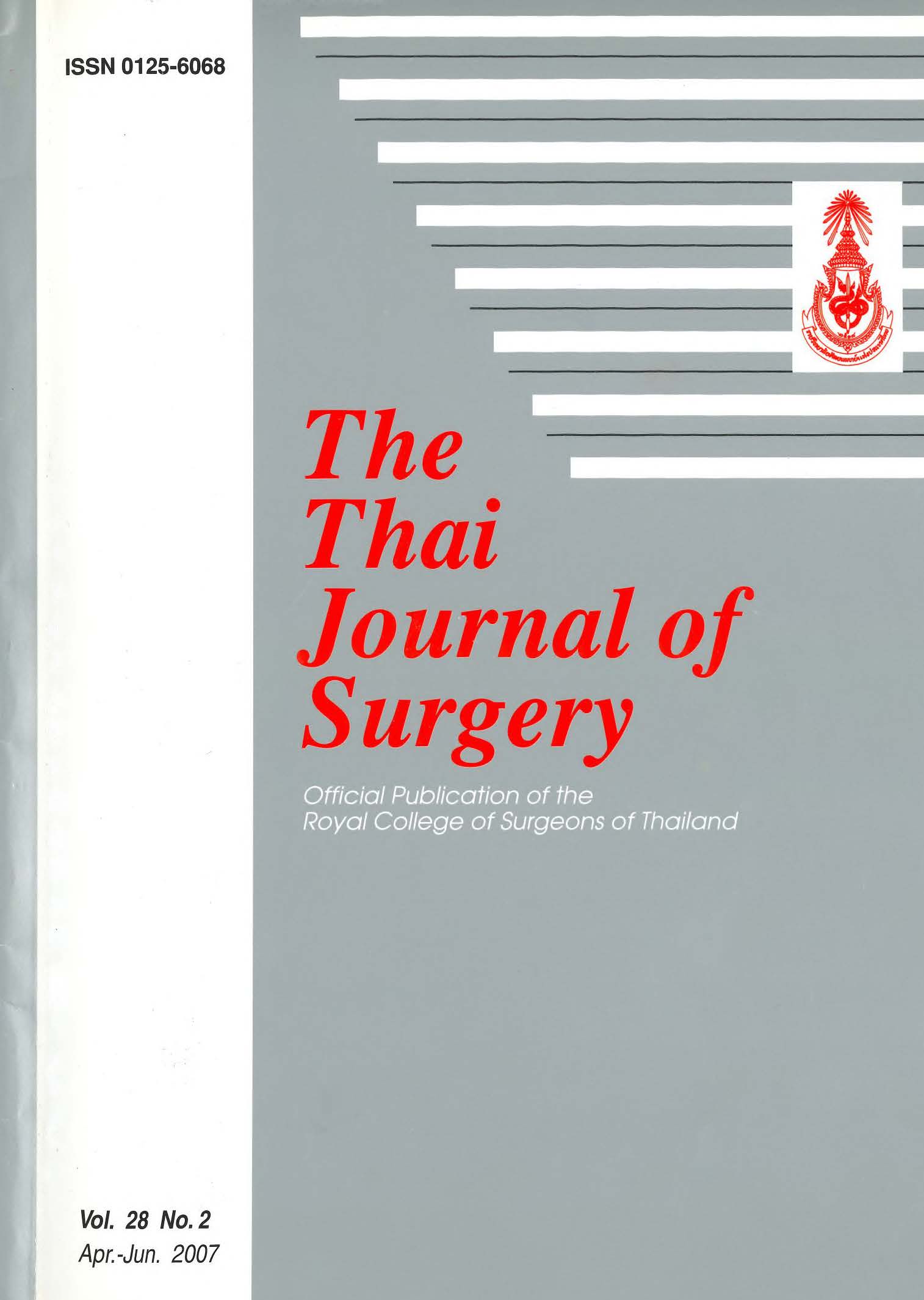Results of Lacrimal Duct Injury Treatment at Phrae Hospital: A Comparison between Microscopic and Pigtail Probe Methods
Abstract
Objective: To comparatively study the management of lacrimal duct injury by microscopic and pig tail probe methods.
Materials and Methods: By evaluating the statistical data on 100 lacrimal duct injuries in 100 patients. 50 lacrimal duct injuries were repaired by microscopic method and the other 50 by pigtail probe method.
Results: The reduction of operating cost, operating time and hospital stay in patients treated with the pigtail probe method were statistically significant compared with the microscopic method (p <0.001).
Conclusions: It is recommended that the lacrimal duct injury be repaired by a pigtail probe method not only to obtain the satisfactory results but also to reduce the operative cost, the operating time and the hospital stay.
References
2. Kartch MC, French-eye pigtail probe for lacrimal canaliculus repair. Am J Ophthalmol 1971;72:1145.
3. Maccord CD Jr. The lacrimal drainage system. Clinical Ophthalmology, Duane, Philadelphia: Harper and Row;1980. p. 1-25.
4. Kaufman H, Champman R. Modified probe for canaliculus surgery. Am J Ophthalmol 1962; 54:461.
5. Viers ER. Malleable rods for immediate repair of the traumatically severed lacrimal canaliculus. Tr Am Acad Ophthalmol & Otol 1962; 66: 263.
6. Scheie HG. An Aid to Repair of lacerated tear ducts. Arch Ophthalmol 1964; 55: 34.
7. Shannon GM, Hamdi TN. Repair of injuries of the lacrimal canaliculus. Am J Ophthalmol 1966; 62:974.
8. Gibbs DC. New probe for the intubation of lacrimal canaliculi with silicone rubber tubing. BrJ Ophthalmol 1967: 51: 198.
9. Johnson CC. A canaliculus wire. Am J Ophthalmol 1974; 78: 854.
10. Hanselmayer H. Prognosis of injured canaliculi in relation to elapsed time until primary operation. Ophthalmologica 1973;166:175.
11. Hazrati, Ezatollah. Nasolacrimal duct injury after Le Fort I osteotomy. Plast Reconstr Surg 1996; 97: 874.
12. Kohlaas M, Wiegmann L, Gaszeyk M, Water A, Schaudig U, Richard G. Lacrimal duct treatment with ring intubation in injuries of the upper and lower eyelids (in German), Ophthalmologe 2001;98: 743-6.
13. Kersten RC, Kulwin DR. "One-stitch" canalicular repair. A simplified approach for repair of canalicular laceration. Ophthalmology 1997; 104: 2-3.
14. Herzum H, Helle P, Hintschich C. Eyelid injuries: epidemiological aspect (in German), Ophthalmologe 2001; 98:1079-82.
15. Olver J. Colour atlas of lacrimal surgery. 1st ed. Oxford: Butterworth Heinemann; 2001.
16. Brigita DO, Matej B, Trauma of the lacrimal drainage system: retrospective study of 32 patients. Ophthalmology 2004;45:292-4.
17. Worst JG. Method for reconstructing torn lacrimal canaliculus. Am J Ophthalmol 1962; 53: 520.
18. Wright P. Ophthal Soc. U.K., and personal communication1970;90:218.
19. Sauders DH, Shannon GM, Flanagan JC. The effectiveness of the pigtail probe method of repairing canalicular lacerations. Ophthalmic Surg 1978; 9: 33-40.
20. Smiths JW, Aston SJ. Soft tissue injury of the Grabb and Smiths plastic surgery, 4 ed. 1991; 1: 332-4.
21. McCarthy JG. Reconstruction of the eyelids and associated structures. In: McCarthy JG, editor. Plastic surgery Vol. 2, The face part 1. Philadelphia: WB Saunders; 1990. p. 1730-3.
Downloads
Published
How to Cite
Issue
Section
License
Articles must be contributed solely to The Thai Journal of Surgery and when published become the property of the Royal College of Surgeons of Thailand. The Royal College of Surgeons of Thailand reserves copyright on all published materials and such materials may not be reproduced in any form without the written permission.



